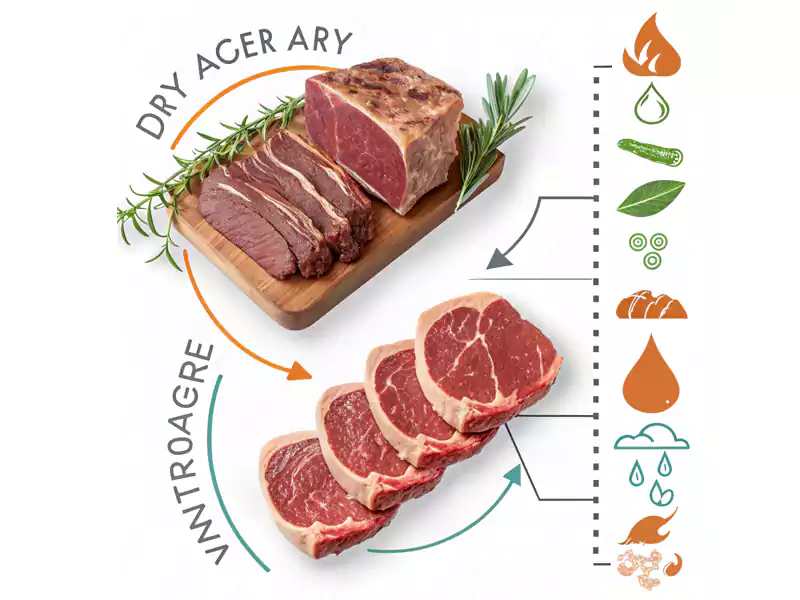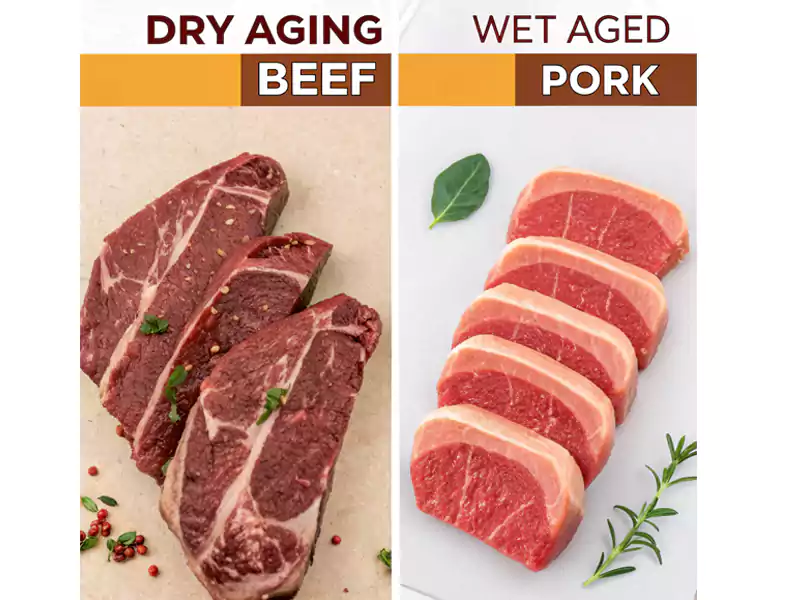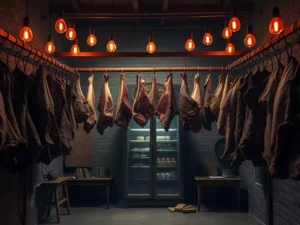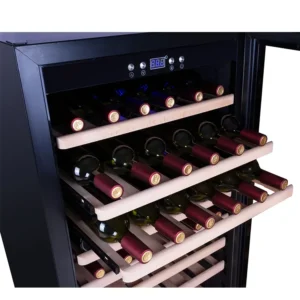When it comes to aging meat, two popular methods dominate the conversation: dry aging and wet aging. Both methods are designed to improve the flavor and tenderness of meat, but they each have their own distinct process, benefits, and drawbacks. In this article, we’ll dive into both techniques and compare them to help you decide which is better for your meat.

What is Dry Aging?
Dry aging refers to the process of hanging meat in a controlled environment with specific temperature and humidity settings. The meat is exposed to air, allowing it to naturally dry out and develop complex flavors over time. Typically, this process can take anywhere from a few weeks to several months, depending on the desired result.
Benefits of Dry Aging:
- Enhanced Flavor: The meat develops a richer, more intense flavor profile, often described as nutty, earthy, and beefy. This is especially true when you age cuts like dry ager beef.
- Tenderness: The aging process helps break down muscle fibers, resulting in more tender meat.
- Texture: Dry-aged meat tends to have a firmer texture and a slightly drier exterior, which many steak lovers appreciate.
Common Meats for Dry Aging:
- Beef (especially prime cuts like ribeye, sirloin, and T-bone, often referred to as dry aged beef)
- Steak
- Salami (for those interested in the world of charcuterie, dry ager salami is a great example of how dry aging can enhance flavors in cured meats)
What is Wet Aging?
Wet aging involves placing meat in a vacuum-sealed bag, where it ages in its own juices. This process is generally faster, taking anywhere from a few days to a few weeks, and doesn’t require the same environmental control as dry aging. Wet aging is typically more affordable and accessible for both home cooks and commercial kitchens.
Benefits of Wet Aging:
- Retains Moisture: The vacuum-sealed bag locks in moisture, resulting in a juicier cut of meat.
- Quicker Process: Wet aging is faster and less labor-intensive, which makes it a more economical option for many.
- Affordable: Generally, wet aging requires less specialized equipment, which makes it more budget-friendly than dry aging.
Common Meats for Wet Aging:
- Beef (cuts like ribeye, strip loin)
- Pork
- Lamb

Dry Aging vs. Wet Aging: A Side-by-Side Comparison
| Feature | Dry Aging | Wet Aging |
| Flavor | Rich, nutty, and beefy | Retains natural meat flavor, slightly less intense |
| Texture | Firmer, with a slightly drier exterior | Juicy, tender with a softer mouthfeel |
| Time | Longer process (weeks to months) | Shorter process (days to weeks) |
| Cost | Higher due to specialized equipment and time | More affordable, less equipment needed |
| Moisture Loss | Loses moisture, leading to a smaller yield | Retains moisture, minimal shrinkage |
| Shelf Life | Longer shelf life, but susceptible to spoilage without proper conditions | Shorter shelf life but still tender after aging |
Frequently Asked Questions About Dry Aging:
Is Wet Aged Meat Better Than Dry Aged Meat?
It depends on what you’re looking for. Wet-aged meat is more affordable and tends to retain more moisture, making it juicier and less expensive. However, dry aged beef offers more complex flavors and a firmer texture, which many steak connoisseurs prefer. For pure flavor and a more premium eating experience, dry aging is generally considered the better option, but it all comes down to personal preference and budget.
Does Dry Aging Make Meat Taste Better?
Yes, dry aging does make meat taste better—for many people, it enhances the beef flavor. The process intensifies the natural flavors of the meat, giving it a richer, nutty, and more complex taste. The natural enzymes at work during dry aging also break down the muscle fibers, making the meat more tender. However, this stronger flavor may not appeal to everyone, as some may prefer the more neutral flavor of wet-aged meat.
What Are the Disadvantages of Dry Aging Meat?
While dry aging provides many benefits, it does have its downsides:
- Higher Costs: Dry aging requires a specialized environment, equipment, and more time, which increases the cost of both the process and the meat.
- Moisture Loss: During the dry aging process, moisture is lost from the meat, resulting in a smaller yield.
- Time-Intensive: Dry aging takes much longer than wet aging, requiring weeks or even months to achieve the desired results.
- Risk of Spoilage: If not properly monitored, dry-aged meat can spoil due to exposure to air and moisture loss.
Is Dry Aged Meat Healthier?
From a nutritional perspective, dry-aged meat isn’t necessarily healthier than wet-aged meat. The nutritional content of the meat remains relatively the same, but the process of dry aging can reduce the moisture content, leading to slightly higher concentrations of proteins and fats per unit weight. The difference in health benefits is minimal, but the tenderness and flavor enhancement from dry aging make it a more desirable choice for culinary purposes.
Can You Dry Age Pork?
Yes, you can dry age pork. While it’s less common than dry aging beef, pork can also benefit from the dry aging process. It can develop a rich, tender texture and enhanced flavor similar to dry aged beef, but it requires careful attention to temperature, humidity, and aging time. Pork cuts like pork loin or pork belly are typically used for this process.
Dry Aged Beef Temperature and Humidity: Key Considerations
When dry aging beef, maintaining the right temperature and humidity is crucial. Typically, dry aged beef temperature and humidity should be kept between 34°F to 38°F (1°C to 3°C) and 80-85% humidity. This ensures that the meat ages properly, developing that rich, nutty flavor and tender texture without spoiling.
Which Method Is Better for Your Meat?
The choice between dry aging and wet aging ultimately depends on several factors:
- Flavor Preference: If you’re looking for a rich, deep flavor with an earthy undertone, dry aging is your best option. It’s especially popular in high-end restaurants and steakhouses.
- Tenderness: Both methods result in tender meat, but dry aging provides an extra level of depth to the texture, which many steak enthusiasts love.
- Time and Budget: If you’re looking for a quicker and more cost-effective option, wet aging is the way to go. It’s also more accessible for home cooks without specialized aging chambers.
- Meat Type: Dry aging works best with higher-quality cuts of beef, while wet aging can be used for a variety of meats.
Comprehensive Overview
Both dry aging and wet aging offer unique benefits and can enhance the quality of your meat. If you’re after complex flavors and premium texture, dry aging might be worth the investment. However, if you prefer a juicier, more economical cut with minimal effort, wet aging could be the right choice for you.
No matter which method you choose, both processes help improve the overall eating experience, and with the right equipment, you can start aging your meat at home or in your restaurant today. You can even distribute them to expand your business.







